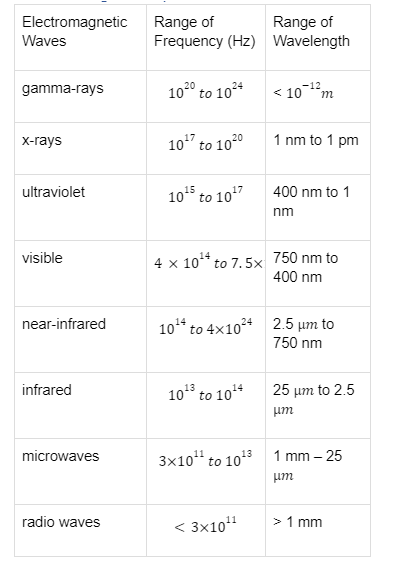Introduction
The sun is our planet’s primary energy source, and its energy is transmitted by electromagnetic radiation. Electromagnetic energy travels at the speed of light across empty space in the form of waves of electric and magnetic fields with a variety of frequencies and wavelengths.
Electromagnetic Radiation
In our daily lives, we are exposed to electromagnetic radiation on a regular basis. EM waves include everything from visible light that our eyes can perceive to microwave radiation which heats our food or radio waves that power our radios, X-rays that allow doctors to detect any injury in our bones, and UV radiation emitted by a hot surface.
Electromagnetic Waves
Electromagnetic waves are formed by the interaction of vibrating electric and magnetic fields. EM waves are made up of an oscillating electric and magnetic field.
In general, a charged particle generates an electric field. Other charged particles are pushed by this electric field. Negative charges accelerate in opposite direction of the field, whereas positive charges accelerate in the field’s direction. The magnetic field is created by a travelling charged particle. Other moving particles are pushed by this magnetic field. Because the force acting on these charges is always normal to their motion, it only influences the velocity’s direction, not its speed. As a result, an electromagnetic field is created by a travelling charged particle. Electric and magnetic fields travelling at the speed of light c through open space are referred to as electromagnetic waves.
Electromagnetic Spectrum
The electromagnetic spectrum is a combination of electromagnetic wave frequencies, wavelengths, and photon energies extending from 1Hz to 1025Hz, comparable to wavelengths ranging from a few hundred kilometres to a size smaller than an atomic nucleus.
In general terms, the electromagnetic spectrum can be defined as the range of all types of electromagnetic radiation. All electromagnetic waves travel at the same speed as light in a vacuum. The wavelengths, frequencies, and photon energy of different types of electromagnetic waves, on the other hand, will vary.
Electromagnetic Waves in Electromagnetic Spectrum
Electromagnetic waves are given here on the basis of decreasing electromagnetic spectrum wavelengths.
Radio Waves
These waves are caused by the rapid movement of charged particles across conducting wires.
They carry radio, television, and telecommunications signals.
The frequency range of these waves is from 3kHz to 300MHz.
Cell phones use radio waves to transmit voice communication in the ultrahigh-frequency (UHF) band.
Radio receivers pick up radio waves transmitted by radio stations.
In space, radio waves can be released by gases and stars.
Radio waves are mostly employed for television and mobile communication.
Microwaves
Microwaves are a form of electromagnetic radiation with a few gigahertz frequency (GHz).
They’re made using vacuum tubes called klystrons, magnetrons, and Gunn diodes.
Because of their short wavelengths, microwaves are frequently used in aviation navigation.
Microwaves, which help in the heating of meals in homes and offices, use these rays. Astronomers use it to figure out and understand the structure of nearby galaxies and stars.
Infrared Rays
Hot bodies and molecules produce infrared waves, which are referred to as heatwaves.
Infrared rays are at the visible light spectrum’s low-frequency or long-wavelength end.
These radiations are trapped in the earth’s atmosphere by greenhouse gases like carbon dioxide and water vapour.
The greenhouse effect which is caused by these rays is critical for maintaining global warming and average temperatures.
Visible Rays
Electromagnetic waves which can be seen with the naked eye are known as visible rays. Electromagnetic waves of this type are the most common.
The visible light rays reflected or released by the items in our environment aid us in seeing the world, and the range of visible radiation varies by creature.
Ultraviolet Rays
Although the sun is the main source of ultraviolet radiation on Earth, the majority of UV energy is absorbed by the ozone layer before it reaches the atmosphere.
The wavelength of UV radiation is 400 nm–1nm.
These rays are emitted by special lights and highly hot bodies, and if they are in large enough quantities, they can cause serious injury to humans. It causes burns and tans the skin.
These radiations are employed in extremely precise applications such as LASIK or laser-based eye surgery because they may be focused on narrow beams.
In water purifiers, UV lights are utilized to kill any microorganisms which may be present in the water.
X Rays
Outside of the ultraviolet (UV) area of the electromagnetic spectrum, this electromagnetic radiation is particularly useful in the medical industry.
X-rays can be created by bombarding a metal target with high-energy electrons.
X-rays are a medical diagnostic method that can be very useful in the treatment of certain types of cancer. A doctor uses an x-ray scanner to scan our bones or teeth to determine the root of the problem.
Gamma Rays
The largest gamma-ray producer is the universe.
These rays are in the higher frequency range of the electromagnetic spectrum.
High-frequency radiations are emitted by radioactive nuclei, which are also produced during nuclear reactions.
Gamma rays are used in a variety of medical procedures, including the killing of malignant cells.

Conclusion
Waves that are related to both electricity and magnetism are known as electromagnetic waves.
Maxwell’s equations are used to derive the electromagnetic equations.
The electromagnetic spectrum can be defined as the range of all types of electromagnetic radiation.
Radio waves are caused by the rapid movement of charged particles across conducting wires.
Microwaves are a form of electromagnetic radiation with a few gigahertz frequency (GHz).
X-rays can be created by bombarding a metal target with high-energy electrons.
Electromagnetic waves which can be seen with the naked eye are known as visible rays.
 Profile
Profile Settings
Settings Refer your friends
Refer your friends Sign out
Sign out






